Allen Chapel, AME
305 West Commercial Ave, Anaconda
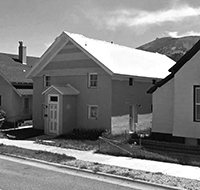
Now a residential home, 305 West Commercial in Anaconda has provided many different functions, for many different people and in different locations since its construction in 1888. Originally, the wood frame and brick veneer building served as the Carroll school house. Carroll, an often forgotten town sat on a rounded hill overlooking the Deer Lodge Valley, and the Smelters of Marcus Daly’s Anaconda Company. It was built to house workers of the Lower Works, which stood nearly a mile from the Anaconda Townsite. When the Washoe Works opened in 1902, its quaint one and a half story school house was abandoned. The building stood empty for a full year before the Reverend Jordan Allen of the African Methodist Episcopal churches of both Butte and Anaconda sought to procure it for use as a permanent home for his followers in Anaconda. The lot at 305 West Commercial had been given to the Anaconda AME which had formed shortly after 1900, by Mrs. Margret Daly in June of 1903. Soon after, the Anaconda Company, owner of the vacant Carroll Schoolhouse, donated the building to Allen and church of Anaconda. On June 8, 1903, Allen laid the corner stone for the new sanctuary. Five days later, he and other members began the long process of dismantling, and moving the building to West Commercial. [1]
The beloved Reverend Jordan Allen pastored the Anaconda AME congregation as well as Butte’s Shaffer’s Chapel for the remainder of 1903 and into 1904 until he took a short reprieve in Denver, Colorado before returning to Montana in 1906 to pastor St. James AME in Helena. [2] The tendency for early AME clergymen to change congregations and move cities so frequently could itself stem from their governing body, the African Methodist Episcopal Church, which placed heavy importance on Mission, and invigorating local black communities. Often, the board for western AME churches, which at this time was located in Kansas City, had the power to send its ministers to new churches in the state to help the spiritual and political growth of a certain community. Likewise, it could send that pastor to the far reaches of Africa to start new congregations. While it might seem that the lack of consistent leadership within a single church could lead to instability, instead, Montana’s AME churches became connected in new ways, namely through a common leader. Jordan Allen was likely not the first minister to travel to the different towns, and he was certainly not the last. Through this practice of roaming clergymen, African American communities in Great Falls and Helena, knew and cared about the lives of black residents of Butte and Anaconda.
The AME church does not appear in the church directories of Anaconda until 1912, when it was pastored by Rev. E. B. Abbot. It was not until the 1925 City Directory that the AME church in Anaconda named their building after the man who laid the sanctuary’s cornerstone. [3] During the inter-war period, the black population of Anaconda fell from 128 to just over a hundred in 1930, and of those hundred, many were increasingly migratory, seldom staying in Anaconda for very long. By 1947, the congregation sold Allen Chapel. The building—once a school, then a church—became an apartment building, and today, it is a private residence. The house now standing at 305 West Commercial carries practically no architectural inclinations of its religious past, nevertheless, it remains as a testament to an often forgotten Anaconda community.
Shaffer’s Chapel, AME
602 South Idaho, Butte
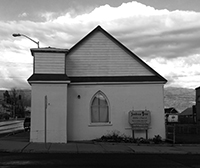
Ostensibly, the copper king William Clark built the small wooden church building that now sits on the corner of Platinum and Idaho as a gift for the African Methodist Episcopal Church, and the black citizens of Butte in 1901. The congregation, only numbering around 20 regular members at the time, moved from their original church building on the corner of Idaho and Mercury, subsequently occupied by the Bethel Baptist Church, the only other black congregation in Butte. [4] Reverend Jordan Allen occupied the pulpit at the new church from 1901, to sometime in 1904 during which time he also pastored the new AME church in neighboring Anaconda, when he moved to Denver, CO for a year. He soon returned to Montana to pastor St. James AME in Helena starting in 1906. [5] In truth, Rev. Allen remained in Butte nearly twice as long a most pastors that would lead services at the little church that came to be known as Shaffer’s Chapel.
After Reverend Jordan Allen left Butte in 1904, Rev. Benjamin McIntyre filled the pulpit. Like Rev. Allen, McIntyre resided at the church. Also like Allen, McIntyre only stayed in Butte for a very short time, through 1906. [6] In fact, from the years of 1902 until 1918 (when the Butte Polk stopped listing Shaffer Chapel’s pastor), twelve different reverends lead services. [7] This was not unique to Shaffer’s Chapel, however. During the early years of religious expansion in the west, governing church bodies often sent new pastors out West to lead congregations before heading larger, urban churches back east. Similarly, hard winters and low pay made keeping new pastors difficult for rural western churches.
Unlike its many reverends during the first twenty years, Shaffer’s Chapel was a mainstay for Butte’s African American community. By 1915, the congregation had more than doubled in size, boasting over 30 members, doubtlessly with many more attending. [8] Even during the first year of the A.M.E. church at the new location, the Butte New Age, which only ran from 1902-1903, printed multiple pieces on the community events put on by the church, or that centered around its members. On March 6, 1913, when Booker T. Washington visited Butte, Shaffer’s Chapel hosted the famous black activist, historian, and writer, with the reception dinner held at the church. [9] Likewise, Armeta Duncan, a leading member of Shaffer’s Chapel, recalls in an interview that W.E.B. Dubois came to Butte to lecture at the college and the black churches. She playfully bragged that both Dubois and Washington visited the Duncan home during their trips to Butte[10]. After WWII, the black population dwindled in the Mining City. Butte’s other African American Church, Bethel Baptist, closed during this time. However, even with the diminished community, Shaffer’s Chapel continued until 1964. [11]
St. James, AME
114 N. Hoback St. (849 5th Ave.), Helena
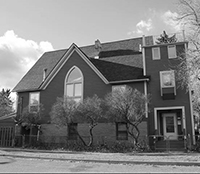
In 1889, Helena’s African-American community built “a handsome frame building with a lime-stone foundation and a steeple” to serve as the Saint James African Methodist Episcopal Church (AME). [12] Helena’s St. James was—along with Portland’s Bethel AME (founded in 1889)—one of the earliest AME churches in the Pacific Northwest. As they did throughout the United States, this church grew to become a central institution of the Helena African-American community. From its base on the corner of 5th and Hoback, St. James fostered “a literary society, a Sabbath school, a women’s benevolent association, a theatrical troupe, a nine-piece band, and a baseball team." [13] The congregation also “organized a library.” [14] In a testament to its early strength and vibrancy, in 1894, just five years after its establishment, St. James hosted the annual convention of the Colorado AME conference.
In the 1890s, St. James had at least three different reverends, including John P. Watson (1894), William A. Moore (1895, 1896), and S. W. Bird (1897, 1898). The relatively short tenure of ministers likely reinforced the importance of lay leaders in the church community, and in these the St. James congregation was rich, for Helena’s African-Americans were energetic and dedicated participants in their church-centered community. In 1894, leaders of the St. James Literary Society were listed in the city directory, and included Jas. Clark, president, A. M. Drew, secretary, and Mrs. Louisa Banks, treasurer. Other lay leaders came from a spectrum of Helena’s black society, including businessmen like Walter Dorsey, Andrew J. Walton, and M. O. J. Arnett, “waiter” J.B. Reid, “plasterer” Ward Cole, “janitor” James Crump, “porter” Miles York, and a “printer” Joseph Tucker. [15]
As the new century dawned, Helena’s black community “was vibrant,” boasting “business establishments, literary and debating societies, a baseball team, and even a progressive newspaper, begun in 1906. Its social center was the St. James African Methodist Episcopal Church at Fifth and Hoback Streets.” [16] In this period, the St. James Literary Society, under the leadership of Walter Dorsey, Mrs. Eugene Baker, and Joseph Clark, was soon counting “over 100 participants at its weekly meetings. The society provided black Helenans with a forum for discussion of community issues, an audience for performing artists, and an opportunity for local poets, playwrights, and essayists to present their work.” The society also sponsored formal debates (followed by “furious discussions”) on such topics as “Resolved, that the Negroes of the South enjoy more prosperity than in any other section of the U.S.” or “Resolved, that slavery was a benefit to the Negro race”; or “Resolved, that woman suffrage is detrimental to the welfare of the nation.” [17]
As before, active lay leaders and intraregional church networks provided continuity and connection even as ministers served but briefly. In 1910, the minister was S.J. Collins, and, according to city directories, the church counted 50 members. That year, St. James stood as one of numerous thriving black churches in the region, and area AME ministers kept busy establishing new ones as well. Ministers Cate & Abbot, for instance, visited Lewistown, Livingston, and Miles City to start churches. Both the Baptist and AME denominations had “regional gatherings that included the four Pacific Northwest states.” [18]
In 1912 the “last black troops left Fort Harrison,” and thereafter the African-American population in Helena and Butte dwindled. Population decline undermined the support base for black businesses and black institutions like St. James, which in turn drove further emigration. Before too long, Helena’s African-American population was “less than a fourth of what it had been in 1900.” [19] St. James continued to function through the 1930s, but after World War II it ceased to exist as a regular church organization. As a legal entity, the St. James AME retained title of the property on the corner of 5th and Hoback until 1973. In the years after it ceased regularly congregating, the AME organization rented the building out. During the 1950s, for instance, it was used by the Assembly of God. In 1973, the St. James organization conveyed the property to James Howard Nybo and his wife Suzanne Mackney. Nybo and Mackney recognized the historic value of the property, and wished to save it from demolition. Hearing rumors that the City of Helena was looking to purchase the property and tear the church down, the young couple contacted the AME Church leadership in Seattle, and arranged to purchase the parcel. After stabilizing it, Nybo and Mackney sold it to Ellen Austin Goers, and the building has served as a residence to subsequent owners ever since.
Union Bethel AME
916 Fifth Avenue South, Great Falls
(text gleaned directly from Barbara Behan’s “Union Bethel African Methodist Episcopal Church National Register of Historic Places Nomination Form,” on file at the Montana State Historic Preservation Office, Helena, MT, 2003)
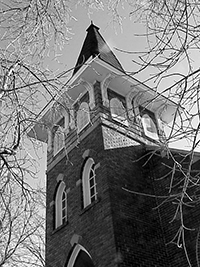
In 1890 the Great Falls African Methodist Episcopal (AME) church organized as a congregation and began meeting in the city’s first fire station on 2nd Avenue South. The next year, Ed Simms, William Morgan and A.W. Ray, trustees of the Great Falls AME, purchased the lot on which the current AME church stands. The property was in a low, swampy area of the southside surrounded by the working-class neighborhood where the town’s black population lived for decades. The original one-story wood frame church was built in 1891; a parsonage adjoined the south side of the building. [20]
The Rev. Joel Childress led the drive to raise money for building the original church. From the beginning, the pastor linked the church’s ecclesiastic mission with secular issues confronting African Americans locally and nationwide. The new church was an active part of the AME structure in Montana and the regional AME organization. When the state hosted the Colorado Conference of the AME church in 1894, the proceedings included a day’s visit to the AME church in Great Falls before reconvening in Helena. The Great Falls congregation also hosted the statewide AME conference in 1908. [21]
The black community in Great Falls remained active in the political arena during the 1890s. In 1892 several members of the AME congregation were involved with a black Democrats’ club, and some black voters attained nomination by the Democratic Party of a black candidate for Great Falls township constable. When he was defeated, the black political activists returned to the Republican fold and in 1894 AME church trustee William Morgan was nominated to the township constable race. The fact that Morgan was elected and served as constable was tribute to Morgan's personal popularity and an indication of the standing of the black community within the larger Great Falls society at the time. [22]
In 1905 the AME congregation paid off a lingering debt from construction of the original building and formally dedicated the church with the first identified use of the name “Union Bethel.” [23] However, by 1916 the original wooden church was falling down, in part because it stood on swampy land. Between September 1915 and April 1917, two successive pastors appealed to the Great Falls public for financial assistance toward building a new church. In a letter published in the Great Falls Tribune Daily, Rev. W. H. Prince compared the AME in Great Falls’ black community to the YMCA in the white community, and wrote that the “remodeling of our church, with some needed additions, means much for the moral and social life and advancement of our people…” [24] In January 1917 the Great Falls Leader reported “the building is planned as a sort of social center for colored people.” [25]
Between 1915 and 1917, with support from the white community, the church raised the money needed to build the existing wood-frame, brick veneer church and a small wood-frame parsonage. Construction began in April 1917. [26] True to its roots, Union Bethel continued to serve diverse social and civic purposes. The church provided a forum in which African Americans and white Great Falls residents could mix socially in what was generally a restrictive social environment. Union Bethel opened its doors to the community, and in varying degrees, people in the white population supported and participated in AME events. The church hosted fundraising dinners that became well-known social events, attended by both black and white Great Falls residents. Edna Jones lived a block away from Union Bethel as a child. In an interview in 1982, she summarized the church’s importance to her family: “When we were growing up, the…African Methodist Episcopal Church…was the center of the social life of all of the black families.” [27]
In keeping with the Progressive Era spirit of the times, Union Bethel women formed organizations to benefit the church and community. These included a Ladies’ Aid society and a missionary group. Certainly one of the most active organizations to spring from the AME church during the Progressive Era was the Dunbar Art and Study Club, which women of the AME church organized in 1920, six years after Montana women gained the vote. For decades the club performed charitable and literary deeds for the church and Great Falls; it was especially active in promoting civil rights. [28]
The 1950s can be seen a turning point after which the history of Union Bethel Church shifted as economic and social realities in Great Falls changed. The assignment of black airmen to East Base/Malmstrom Air Force Base in the 1950s brought in new African American residents, some of whom stayed in Great Falls after retirement. In the 1960s and 1970s, thousands of employees lost jobs in Great Falls’ traditional job sectors in smelting and rail repair. At the same time, many young people left Great Falls to seek better educational opportunities. After about 1950, then, the influence of older and established black families tapered off and new families moved in. At times Union Bethel suffered sporadic or low membership. By 1950, part of the parsonage was gone and by 1969, the city directory shows the AME minister living at a different address. From 1973-86 the church lacked a resident minister and operated with lay leadership from dedicated members. [29]
In the 1990s, the AME Fifth Episcopal District bishop appointed Rev. Robert Payne, an ordained Air Force officer from Malmstrom Air Force Base, to the ministry at Union Bethel. Today, the congregation is flourishing under its new leadership with a multi-racial mix of Air Force personnel and a small but influential group of long-term members and their extended families. Union Bethel is the largest of three AME congregations in Montana, the other two in Billings and Bozeman.
Wayman Chapel, AME
402 South 25th Street, Billings
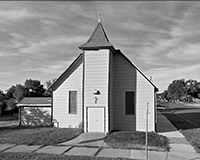
A hard date for the initial construction of the Wayman Chapel in Billings is difficult to ascertain. Local members functioning as church historians put the date of construction somewhere around 1895 or 1896. [30] The Billings Polk city directory of 1901 lists the church as being organized in 1900, at the location on N 24th St. [31] In 1909, newspaper sources and architectural firms have documented the AME church’s desire to build a new building, even going so far as to hire a firm to design the structure. The Billings Gazette published an article in July of 1909 stating that the Bishop of the AME churches was scheduled to arrive in Billings to dedicate the new church. [32] However, it does not seem that the new construction ever came to fruition. Instead, the original salt-box style building which was built in the mid-1890s, and rented by the congregation starting in 1900, received a new steeple and false gable front, both features still prominent today.
1916 the members of Wayman Chapel purchased the building outright, and proceeded to move the entire building to Billings’ Southside. The new neighborhood was already the center of the African American community in Billings thanks to the early black pioneer Walker Browning settling on the south side of the tracks in the 1880s. The church now stood only blocks from the Browning’s home, at the time belonging to his daughter and her husband the esteemed Calvary Captain Horace Bivins, as well as Mrs. Browning’s furnished rooms, at 121 S 26th St. The McCabes, Emmons, and other founding members also lived within a few blocks of the new location. Membership at Wayman Chapel remained at eight to twelve individuals for a number of years. [33] It is presumed that they included, Walker and Ruth Browning, Horace and Claudia Bivins, William and Lulu McCabe, Robert and Candis Emmons, Walter and Angeline Chase, and Ms. Edna Brown. In time, the membership of the small chapel would grow to over thirty or forty members, with many more attending. From 1910 to 1916, three different pastors filled the pulpit on Sundays. The 1920s continued to see an inconsistency in the position of spiritual lead for the congregation. Albert Liles, H.C. White, and David Somerville all were sent by the main AME Church body to lead the services. Not until the hiring of Rev Robert Freeman in 1957, would the church have a steady pastor. Until his death in 1997, Freeman served as a pillar of the dwindling African American community. [34]
Like many black churches in the west, Wayman Chapel not only served as a religious and spiritual center for the congregants but also as a social center for community events and functions. These functions ranged from very typical dinners and luncheons to raise money for various causes to political movements. The most notable service churches often provided was a space for progressive social groups. As women tended to be the center of the church body, so too did the colored women’s clubs tend to be the center of the black community. This was the case all across Montana, including Billings. The Montana State Federation of Colored Women’s Clubs, or MSFCWC, worked to promote education, the family, and the general enhancement of black women in the home and the community. This state-wide organization had a significant impact on the lives of African Americans in Montana, as they fought to quell prejudice in the community, pushed for civil rights legislation in the Capitol, and helped dozens of black students pay for college. [35] The Billings Chapter, called the Phillis Wheatley Club, along with the Angeline Chase Missionary Society both worked within the Billings community to make a better future for African American children.
